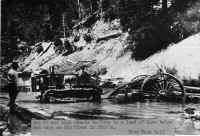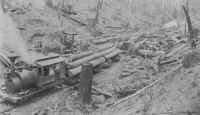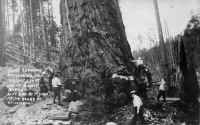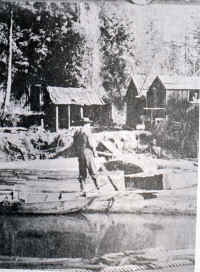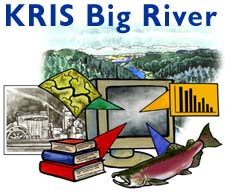Bibliography Background About KRIS
Big River History: Logging and Mills 1900-1950
All photographs provided courtesy of the Mendocino Historical Society and the Held Poage Memorial Home and Research Library, except where noted. Use must be approved by the Mendocino Historical Society. Click on image to see at full size.
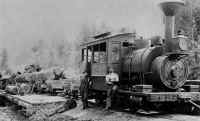 |
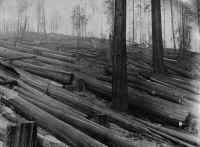 |
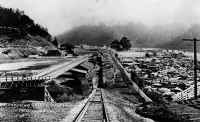 |
| Log train on Big River near Mendocino circa 1900 | One million board feet. Location and photographer unknown. | Looking (east) down the incline towards the Mendocino Lumber Co. Mill prior to 1906 (423KB) |
April 6, 1900 Alfred R. Johnston, logging contractor, was in town looking for hands. ( He had broadened his operations from Dougherty Creek area to include the Louzy Gulch section which was downriver from Laguna creek. Two logging camps were set up)
June 13, 1900 Big River Maru was launched at the mill without fanfare. (It was 40 feet long, 16 feet wide and approximately 3 feet high, with a flat bottom. A stern driven paddle wheel was its motivation. A licensed engineer was required to run the Maru)
November 26, 1900 Mill's Stentorian Whistle made its welcoming sound, announcing the restarting of the mill, it having been shut down since May for want of logs. (A small freshet had brought a few logs down the river)
June 3, 1901 Logging contractor Alfred R. Johnston extended his lower river operations, purchasing property encompassing Hare Creek. (That stream entered the river at the Piers, (Boom) its headwaters 4 miles out on the Comptche Road)
April 12, 1902 North side of mill started up, having been shut down for 15 years. (North and south sides were separate log sawing areas, each requiring its own crews. Generally one of the sides could saw larger logs so it was the most used.)
April 26, 1902 News item: "6 logging camps in operation on the river. Charles Perkins at Laguna Creek and Burnt Jam. Alfred Johnston at Tidewater and Dougherty Creek, David Brandon at the Lower Ranch and C. E. Russell at Tidewater"
May 10, 1902 News item: "Logs that are logs, 11 of them, from 14 feet to 16 feet in diameter, higher than a man's head, were rafted down the river". (They came from Laguna Creek, and before they could be sawn, had to be split to a smaller size)
May 19, 1902 Company's 2nd railroad locomotive, a 30 ton Climax arrived on the steamer Phoenix. (It, and a logging donkey for Alfred R. Johnston, were loaded on to a lighter at the ship and taken across the bar (mouth of river) and 5 1/2 miles upriver.
Jan. 24, 1903 Logs from Dougherty Creek entered the Boom, traveling a distance of 40 miles. (The furthermost distance that logs were driven on the river was from Horsetheif logging dam, some 48 miles distant)
October 13, 1903 Boyle & Ross logging camp received a wagon load of car trucks for what eventually became the largest logging tramway system in the river. ( C. Edward Boyle and William Ross camp was located at the upper Hatch Gulch)
November 7, 1903 Log shortage caused the mill to shut down even though the river was full of logs. (Boyle & Ross logging camp had 40 to 50 tiers in the river, totaling 10/15 million feet, only needing a freshet to move them down the river)
May 22, 1905 Logging contractor Alfred R. Johnston made his last timberland purchase on the river. (In his 20 years to this date on the river, he acquired nearly 8,000 acres, logging a great portion of them, then selling the property)
December 15, 1905 Incorporated as a new concern, The Mendocino Lumber Company came into being with C.R. Johnson as president. (He owned the Union Lumber company, was principal stockholder in this acquisition. Union took full control in 1944)
April 18, 1906 Mill heavily damaged by the San Francisco earthquake. (The mill's most prominent feature, the 1,000,000 brick [square] chimney, collapsed. Its bricks had been hauled to the site by Napoleon Bever. The mill's main flywheel also was damaged)
May 13, 1906 Workers at the mill were called back to work by the joyful sound of its whistle announcing that the earthquake damage had been repaired. (During the shutdown, the workers had received partial payment of wages)
July 3, 1906 Alfred R. Johnston, logging contractor, acquired the Orr & Evans sawmill at Low Gab and its properties. (The concern had gone into bankruptcy. This venture by Johnston proved to be costly for him)
Feb. 5, 1907 Rainfall total for the past seven days was 16.18 inches. (The river ran so fast that logs in the millpond, the company's gasoline boat, log sawing machinery and floating windlass, all went to sea with the runoff water.)
July 13, 1908 Alfred R. Johnston, logging contractor in town, and reported that the logging camps had been closed. (Closures during the height of a logging season did occur, either because of a poor lumber market, or no log drives)
November 14, 1908 News item: "A raft of logs, nearly 1/3rd mile long, one end invisible from the other, having 1500 logs, which equaled 800,000 feet of lumber, was moved down the river by the Maru; Perley Maxwell was engineer"
April 26, 1909 Mill's south side began operating, having been shut-down for general repairs. (A new carriage with an 84 inch head block was installed so that it could carry a 7 foot log for sawing into lumber)
April 29, 1910 "Peck" Switzer completed hauling a disassembled 35 ton locomotive from Navarro flat. (The location of an old lumber firm. The machine was re-assembled and placed into service on the river, the 3rd such improvement)
June 23, 1910 Company received a new and large Bull Donkey yarder. (It had a piston stroke of 14 inches, its cylinder was 11 inches in diameter. The drums carried 3 miles of cable, enabling the machine to move logs from a point over one mile distant)
August 31, 1910 Charles B. Mallory shut down his logging operations on Ramon Creek for the winter. (His first logging contract tools were: a horse team, bull team and jackscrews. His next season he added a small donkey engine)
September 6, 1912 Contractor William H. Burke was aided in getting his railroad ties down the river by an usual rainfall, which totaled 4 1/2 inches. (During the summer months, Burke drove ties by aid of a small dam at the Company's Lower Ranch)
Jan. 26, 1912 Andrew Burbeck drowned in the attempt to break up a log jam near Tow Log Creek. (He and John Johnson had been sent out by the Company to do this work. The logs in this instance had only moved from log tiers placed 3 miles away)
July 25, 1912 Five cars of logs were moved over the newly completed 3 mile railroad extension from Laguna Creek to the Little Northfork. (The railroad was extended up into that branch and its tributaries. Used for 24 years of logging)
November 6, 1912 Earliest log drive ever recorded occurred when an unusual rain storm dropped 6 inches of rain in less than 36 hours. (This enabled some 25,000 logs to come down the river and into the Boom)
June 23, 1914 Cecil Mallory killed a panther with a 6 shooter. (He was delivering a bullteam to Johnston's logging camp on the Main river. This 4 yoke team was the last animal team used for logging on the river)
March 6, 1916 Boyle's logging camp opened for the season. (A new logging camp, 1 1/2 miles up the little Northfork, and another on the same tributary at the mouth of Thompson Gulch had been added. Thomas Ellison's bark camp was nearby, at Thompson Gulch)
June 19, 1918 Fire destroyed one-half million feet of logs tiered in the river at Ellison's logging camp. (Logs were tiered in the riverbed in preparation for driving. They were piled on top of each other, from bank to bank and to top of same)
March 2, 1919 Logs on the Southfork began moving out as the 5th drive for the season got underway. (Two drives were the average. There were many seasons when no drives occurred, 1907/08, 1909/10, 1919/18, 1919/20 and the depression years 1932-34)
June 4, 1919 Company's new gasoline speeder for the railroad arrived and was taken up the river on the Maru. (It was placed on the tracks, and, under its own power, traveled to Boyle's logging camp. Used to transport men to/from work)
November 23, 1919 Company ordered a locomotive and Holt tractor to replace the animal teams in moving lumber from the Mill to the Incline and Incline to the shipping Point.
December 6, 1919 The new Maru, Big River #2 was launched at the mill. (Its designer and builder was John Peterson. The principal difference between the new craft and the old one was the shed roof over the paddle wheel)
December 19, 1919 Boyle's logging camp on the Little Northfork closed for the season. (Logging at the time was in Railroad Gulch, where today's road to the river is located. In this gulch was felled a 19 foot diameter redwood tree)
December 29, 1919 The new Maru, Bib River #2, made a fast run to the Boom, taking 25 minutes on a slack tide. (It was the last such type of craft. Some of its remains still rest n the north bank mudflat, across the river from Iron Pin Hole.
May 31, 1920 Levi Anderson, pond employee at the mill, decided to see for himself where the sinkers were located. (Sinkers were logs that became water-logged and too heavy to float, thereby sinking to the river bottom)
July 1, 1920 Mill shutdown for lack of water. (The boilers required 80,000 gallons per day. All water sources had dried, from across the river at the mill to the upriver tributaries, one mile distant. This is between today's rockpit and the New Boom)
August 13, 1920 Charles B. Mallory in from his former logging camp near Hells Gate, to a new logging operation of Tidewater. (The new logging area was located between Reserve Gulch (Rockpit) and what was later to become the New Boom)
December 17, 1920 The smallest log jam on the Southfork moved down the tributary one mile, only to become part of another and much larger jam. (Hellsgate and Anderson Creek logging dams had to be let go many time in order to break this log jam.)
August 7, 1921 First tractor used for logging on the river, a 14 ton Holt, broke through the bridge on its way to Charles B. Mallory's logging camp, coincidentally known as the River camp. (This machine was Mallory's personal property)
Feb. 18, 1922 4,000 logs broke free from the large log jam on the Southfork. (Two logging dams, Hellsgate and Anderson Gulch, dynamite and other equipment were used during a 4 year effort to break up the river's largest and longest log jam)
July 18, 1922 John Norberry went to Hellsgate logging dam, where he was to add another gate in the structure. (The original one was not large enough to let out water fast enough. Logging dam gates were approximately 10 by 16 feet)
May 3, 1923 The first second-growth redwood logs were sawn into lumber at the mill. (54,000 feet of logs were removed from a one acre parcel. The trees were 60 years old and a few had obtained a 4 foot diameter: Professor Emanuel Fritz, forester)
July 21, 1923 Company reported that work had commenced on building a new logging dam. (Located on the Big Northfork at East Branch. John Norberry was in charge of construction. Cecil Mallory gathered the required timbers)
October 2, 1924 Big Northfork logging dam was reported by the Company as being completed. (This was the 27th and final confirmed structure, built for the purpose of supplementing freshet waters needed for driving logs down the river.)
November 21, 1924 Seedling redwood trees arrived for the company's reforestation program. (The trees were planted in what is now known as Railroad Gulch, the one leading down to the Little Northfork. Guerdon Ellis, forester, was in charge)
December 6, 1924 Four logging dams turned loose, including the big Northfork for its first time. (Hellsgate dam on the Southfork, Valentine Creek and the Johnston dam on the Main River, plus Northfork, made up the so-called "Big 4" dams)
April 24, 1925 Three trucks were used to haul a cable to Charles B. Mallory's logging camp at the big Northfork. (A queer sight to see a coil of cable on the 1st truck, draped over to the 2nd truck, coiled and thence over onto the 3rd truck)
May 19, 1925 Season's latest recorded log drive occurred as a late storm dropped 3 1/2 inches of rain. (May had but 3 drives in the 86 year logging period. January had 29%, February 25%, December 14%, March 13%, April 9% and November had 7%.
September 16, 1925 Charles B. Mallory received a gold watch from his workers. (Mallory had just retired from logging. His 16 years on the river were unique in that he did not have a single death among his crews. He had 5 camps, built/operated 4 logging dams.)
May 21, 1926 Mill shut down, shortage of logs. (Extreme low tides revealed the presence of sand bars and debris which had filed the log storage area at the Boom. This prevented the rafting of logs to move them down the river to the mill)
June 24, 1926 Marie Bakke, the third largest ship ever to enter the bay, taking on a cargo of railroad ties. (In 1909 the second largest ship, Oswestry, at 353 feet long, could and did take on one and one half months of the mill's lumber output)
December 30, 1926 The phrase Old Boom came into being as the last of four piers which formed it was removed from the river. (A new Boom had been completed. The old boom log storage area had filed with debris after 60 year of holding logs)
May 8, 1927 Colonel W. B. Greeley, head of the United States Forestry Department, arrived for a two day visit. (He came to inspect the reforestation on the river, then being undertaken. He was accompanied by T. D. Woodbridge)
May 24, 1927 Company's new gasoline yarder arrived, the beginning of the end of using steam powered machinery in the logging woods. (As a woodsman stated, "this ended the hearing of yarder whistles, from Albion to Ten Mile river logging areas")
June 1, 1927 Newly acquired and ponderous yarder presented a most unusual sight in wending its own way down the highway. (Its journey began at fort Bragg and ended on the river via Little Lake Road, the first such machine with tracks)
December 24, 1931 Three logging dams on the river were let go, and for the Johnston Dam, it was the final time. (This structure became noteworthy in that it was the last one to be torn down, 1952, and yet it was in shape, ready to be used again)
Jan 20, 1936 Boyles camp opened for its final logging season. (This camp was established in 1912, the longest one operated from the same site. Mendocino Woodlands, a Federal project, was to acquire this location and converted it to other usage)
August 6, 1936 First logs moved by truck arrived at the mouth of Laguna Creek. (Joe Lenhares and John Rodgers unloaded the truck. Edward Mathews and Martin Rodgers reloaded the logs onto the train.
September 22, 1936 Edward Mathews injured in transferring logs from a truck to one of the last trains ever to haul logs on the river.
October 27, 1936 $31,616.48 check received by the Company for 3382 acres of cut-over timberland, principally being the Little Northfork of Big River. (Mendocino Woodlands project came into being with WPA and PWA participation)
Feb. 3, 1937 The final log drive ever on the river occurred, one that involved more than one logging dam. (the drive ended in failure; the water ran around the logs which had been tiered at the mouth of Little Northfork)
May 7, 1937 First truck load of logs was transported on the logging road extension from Laguna Creek to near the former railroad log dump. (From this point, the logs were handled as before, rafted and taken to the mill pond)
August 10, 1938 Second part of the Simon Benson log raft was towed into the Bay. (The raft being towed had been nearly 1,000 feet long, 52 feet wide, containing up to 5 million feet of logs. Many such rafts passed by this place)
November 5, 1938 The mill began its final month of ever sawing lumber, closing on November 30, 1938. Ironically, the logs sawn came by sea. (The first lumber sawn in Mendocino was in 1853, a span of 86 years)
November 24, 1938 The steamer Noyo entered the Bay and received a deck load of lumber, and was the last ship to have done so prior to the mill's closure. (The lumber loaded was from the ill-fated Benson log raft)
December 7, 1950 The Mendocino Lumber Company was dissolved, 18 months shy of 100 years. (The 4 companies to operate at Mendocino were: California Lumber Manufacturing Co., Mendocino Mill Co., Mendocino Lumber Co., and the Mendocino Lumber Co.
Infrastructure - railroads, boats, bridges, etc.
Events - floods, storms, shipwrecks, etc
Logging / Mills - operations and events at mills, logging activities
Also see, Big River Was Dammed (excerpts) and Fish stories from the past
Photo: Joshua Grindle at camp in the 1870's. Photo by CE Watkins, courtesy of the Mendocino Historical Society and the Held Poage Memorial Home and Research Library (from the Collection of Robert Lee). (555 KB)
